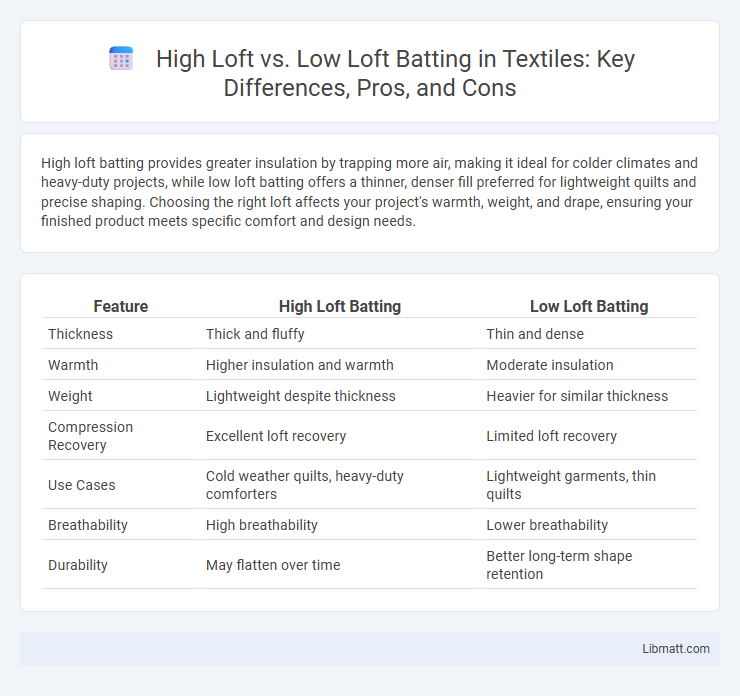High loft batting provides greater insulation by trapping more air, making it ideal for colder climates and heavy-duty projects, while low loft batting offers a thinner, denser fill preferred for lightweight quilts and precise shaping. Choosing the right loft affects your project's warmth, weight, and drape, ensuring your finished product meets specific comfort and design needs.
Table of Comparison
| Feature | High Loft Batting | Low Loft Batting |
|---|---|---|
| Thickness | Thick and fluffy | Thin and dense |
| Warmth | Higher insulation and warmth | Moderate insulation |
| Weight | Lightweight despite thickness | Heavier for similar thickness |
| Compression Recovery | Excellent loft recovery | Limited loft recovery |
| Use Cases | Cold weather quilts, heavy-duty comforters | Lightweight garments, thin quilts |
| Breathability | High breathability | Lower breathability |
| Durability | May flatten over time | Better long-term shape retention |
Introduction to Batting Loft
Batting loft refers to the thickness and fluffiness of insulation materials used in quilts and outerwear, impacting warmth and weight. High loft batting traps more air, providing superior insulation and a puffier appearance, ideal for cold climates and heavy winter garments. Low loft batting offers a thinner, denser fill, allowing for a sleek profile with moderate warmth, suitable for layered clothing or mild weather conditions.
What is High Loft Batting?
High loft batting refers to insulation material characterized by thicker, loftier fibers that provide enhanced warmth and greater volume compared to low loft options. This type of batting traps more air within its structure, improving thermal insulation and offering better cushioning for your home or sewing projects. Choosing high loft batting can significantly increase the comfort and energy efficiency of quilts, jackets, and upholstery.
What is Low Loft Batting?
Low loft batting features fibers that are tightly packed and compressed, providing a thinner, denser material ideal for structured quilting projects. Its reduced thickness offers enhanced stability and support, making it perfect for quilting designs requiring precise detail and less bulk. If your project demands a sleek, crisp finish, low loft batting ensures durability without compromising on shape retention.
Key Differences Between High Loft and Low Loft Batting
High loft batting features thicker, loftier fibers that provide superior insulation and greater cushioning, making it ideal for cold climates or projects requiring maximum warmth. Low loft batting consists of thinner, denser fibers that offer a flatter profile and enhanced durability, suitable for lightweight quilting or applications needing minimal bulk. Your choice between high loft and low loft batting should depend on the desired warmth, thickness, and structural stability of the finished product.
Benefits of High Loft Batting
High loft batting offers superior insulation by trapping more air, providing enhanced warmth and comfort in quilts or apparel. Its lofty structure improves cushioning and loft retention, ensuring your items remain plush and durable after repeated use and washing. This type of batting is ideal for projects requiring a high level of thermal performance and softness, making it a preferred choice for cozy, high-quality bedding and garments.
Benefits of Low Loft Batting
Low loft batting offers superior insulation by providing a denser, more compact layer that effectively traps heat while maintaining a slim profile ideal for lightweight garments. This type of batting delivers excellent durability and support, making it suitable for quilting projects that require sharp definition and minimal bulk. Its low loft structure reduces fabric distortion, enhancing the overall appearance and longevity of finished products.
Best Uses for High Loft Batting
High loft batting offers superior insulation and loft retention, making it ideal for projects requiring added warmth and thickness, such as heavy winter quilts, padded jackets, and upholstery. Its resilient fibers provide excellent puffiness and durability, ensuring sustained comfort and structure in bedding and outerwear. This type of batting is preferred when maximum loft and thermal insulation are desired to enhance softness and heat retention.
Best Uses for Low Loft Batting
Low loft batting is ideal for projects requiring a sleek, dense finish such as quilted jackets, table runners, and lightweight blankets. Its compact structure offers enhanced durability and less bulk, making it perfect for garments and crafts where minimal puffiness and maximum warmth retention are desired. You'll find low loft batting essential when seeking clean lines and a smooth surface in your sewing projects.
How to Choose the Right Batting Loft
Choosing the right batting loft depends on the desired quilt texture and warmth level; high loft batting offers greater thickness, insulation, and a plush finish, making it ideal for cozy quilts and warm blankets. Low loft batting provides a thinner, flatter appearance, perfect for lightweight quilts and projects requiring minimal bulk and easier machine quilting. Consider your project's purpose, fabric type, and stitching method to match Your batting loft choice for optimal durability and comfort.
High Loft vs Low Loft Batting: Final Comparison
High loft batting offers superior insulation due to its thicker, fluffier fibers, providing greater warmth and better air trapping compared to low loft batting's compact, dense structure designed for lighter insulation and increased durability. Low loft batting is ideal for lightweight quilts and garments requiring less bulk, while high loft is preferred for maximum warmth in colder climates. Choosing between high loft and low loft batting depends on the specific requirements for warmth, weight, and garment or bedding thickness.
High Loft vs Low Loft Batting Infographic

 libmatt.com
libmatt.com